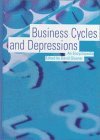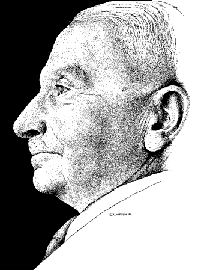
David Glasner, ed., Business Cycles and DepressionsNew York: Garland Publishing Co., 1997, pp. 440-42
Ludwig Edler von Mises
by Roger W. Garrison
 A central figure
of the Austrian School, Ludwig Edler von Mises (1881-1973) contributed
broadly to both theoretical and applied economics. Dating from 1902, his
writings developed into a comprehensive treatment of economic principles
set forth in Human Action, a treatise which first appeared as Nationalökonomie
[1940]. His economic thought is presented as an integral part of a "praxeological"
system—a logic of action in the context of human purpose and the passage
of time. A central figure
of the Austrian School, Ludwig Edler von Mises (1881-1973) contributed
broadly to both theoretical and applied economics. Dating from 1902, his
writings developed into a comprehensive treatment of economic principles
set forth in Human Action, a treatise which first appeared as Nationalökonomie
[1940]. His economic thought is presented as an integral part of a "praxeological"
system—a logic of action in the context of human purpose and the passage
of time.
Though widely known for
denying the possibility of rational central planning and as a life-long
critic of interventionism, Mises also contributed importantly to monetary
and business-cycle theory. In his Theory of Money and Credit, originally
published in 1912 as Theorie des Geldes und der Umlaufsmittel, Mises
demonstrated that the value of money, no less than that of other goods,
is based on its marginal utility. Building upon this early integration
of value theory and monetary theory, Mises sought to explain how both market
forces and bank policy affected the purchasing power of money. He also
provided a clear account, in this first major work, of the credit-induced
boom and subsequent bust. An extended treatment of what came to be known
as the Austrian Theory of the Business Cycle is provided in his "Monetary
Stabilization and Cyclical Policy" and in Human Action. To formulate
a theory of boom and bust, Mises drew insights from three sources: Eugen
von Böhm-Bawerk of the early Austrian School, Knut Wicksell of the
incipient Swedish School, and Lord Overstone and others of the British
Currency School.
From Böhm-Bawerk, Mises
adopted the conception of a production economy whose temporally sequenced
stages of production employ capital goods and other resources. This capital-theoretic
framework, in which some production processes are more time-consuming,
or "roundabout," than others, features a trade-off between the amount and
the timeliness of economic output. In an economy unhampered by perverse
bank policy, the economy's intertemporal structure of production is governed
by the rate of interest, which reflects the "time preferences" of consumers.
That is, the interest rate brings into balance the marginal productivity
of roundaboutness with consumers' marginal utility of goods now as compared
to goods later. Mises' treatment of intertemporal resource allocation did
not differ substantively from Böhm-Bawerk's. Original with Mises was
his use of the Austrian theory of capital and interest as a basis for a
theory of business cycles.
From Wicksell, whose
Interest and Prices was published in 1898, Mises borrowed the idea
that the bank rate of interest sometimes diverges from the "natural" rate
of interest, so called by Wicksell. The natural rate, which excludes all
monetary influences, was taken by Mises to be the interest rate consistent
with consumers' time preferences; the bank rate, which is subject to monetary
manipulation, was taken to be the focus of bank policy. Holding the bank
rate below the natural rate requires a continuous expansion of bank credit.
The divergence of the two rates of interest was of concern to Wicksell
primarily because of its effect on the general level of prices. Wicksell
acknowledged that bank policy might also affect the allocation of resources,
but any such allocational effects were reduced to "tendencies only" by
his simplifying assumptions and thus were no part of his formal theory.
Mises, in effect, relaxed
Wicksell's simplifying assumptions in order to investigate the allocational
effects of bank policy. He was specifically concerned with credit expansion
in the context of time-consuming, capital-using production processes. Tracing
the effects of bank policy on production activity furthered the integration
of monetary and value theory and identified the ultimate consequences of
a cheap-credit policy. Since the natural rate is the rate of interest that
reconciles intertemporal production activities with the time preferences
of consumers, credit expansion, by keeping the bank rate below the natural
rate, induces a fundamental inconsistency. A cheap-credit policy distorts
business calculations causing the production of consumer goods to be reduced
and production processes in general to be excessively roundabout. Mises
used the term "forced savings" to describe the policy-induced reduction
in consumption and the term "malinvestment" to describe the intertemporal
misallocation of resources induced by artificially cheap credit.
Mises transformed his insights
about forced saving and malinvestment into a theory of the business cycle
by recognizing the unsustainability of production activities that are based
upon a low bank rate. But the idea that the market's responses to credit
expansion contain the seeds of their own undoing is older than either the
Austrian or the Swedish School. A self-reversing process triggered by bank
policy had been identified early in the nineteenth century by members of
the Currency School. So similar in form was Mises' theory to the "Circulation
Credit Theory of the Trade Cycle," as exposited by Lord Overstone and others,
that Mises considered his own theory an extension of the circulation-credit
theory rather than a uniquely Austrian theory.
However, Mises found the
formulation of the Currency School to be inadequate in two respects. First,
it gauged bank policy too narrowly in terms of the quantity of banknotes,
ignoring the equally if not more significant volume of demand deposits.
Secondly, and more importantly, it failed to identify any domestic market
forces that might counteract the initial effects of credit expansion. The
unsustainability of the boom in the Currency School's formulation derived
exclusively from international repercussions. As an expansion of banknotes
drove domestic prices upward, exports would fall while imports rose. The
trade imbalance would drain gold, the redemption medium, from the expanding
banks eventually requiring the banks to contract. It is this specie-flow
mechanism, in the Currency School's view, that limits the ability of any
one country to maintain a cheap-credit policy.
Mises' formulation advanced
the circulation-credit theory by showing that credit expansion is unsustainable
even in a closed economy—or in an open one in which the banks of all countries
expand together. In the early phase of a credit expansion, workers receive
income from production activities undertaken on the basis of a low bank
rate of interest, but those same individuals, as consumers, spend their
income at a rate corresponding to the higher natural rate of interest.
This consumer spending eventually counteracts the initial effects of credit
expansion. The rise of consumer-good prices, which demonstrates the true
strength of consumers' preferences for goods now over goods later, discourages
the relatively more roundabout production processes that cheap credit initially
encouraged.
Attempts by the central bank to reinforce the credit expansion will also
reinforce the market's "countermovements," as termed by Mises. As market
forces continuously counteract bank policy, the artificial boom is eventually
brought to an end. Some production processes that were initiated during
the period of cheap credit can be completed only at a loss, while others
must be liquidated. Even apart from international considerations, the credit
expansion contains the seeds of its own undoing.
In sum, Mises saw the boom
as a consequence of unenlightened bank policy, a period of artificial and
unsustainable expansion, in which capital and other resources are committed
to excessively roundabout production processes, and he saw the bust as
the inevitable consequence of the credit-induced boom. In the end, the
pattern of consumer spending wins out over the pattern of bank lending.
Mises saw the recovery as the period during which malinvestments are liquidated
and production activities are again reconciled with actual consumer preferences.
Mises recognized, as did Wicksell, that enlightened bank policy would avoid
credit expansion, thus minimizing the divergence between the bank rate
and the natural rate. Believing, however, that central bank policy as formulated
by government officials would be ideologically biased towards cheap credit,
Mises favored institutional reform in the direction of free banking.
Mises' theory underwent
substantial development by F. A. Hayek, whose Prices and Production
influenced many British theorists, and remains a part of the research agenda
of the modern Austrian School. But the Austrian theory of the business
cycle has not been incorporated into mainstream macroeconomic theory. Several
factors have inhibited a broader acceptance of Mises' views. First, mainstream
macroeconomics since the Keynesian revolution has developed with no grounding
in capital theory of the sort that underlies Austrian business-cycle theory.
Thus, a capital-theoretic account of the unsustainability of a credit-induced
boom, when grafted onto a macroeconomic theory that is otherwise free of
such considerations, appears ad hoc and unduly complex. Second,
because of fundamental difficulties in measuring capital and roundaboutness,
especially in the context of artificial booms and consequent busts, the
empirical—largely episodic—support for the Austrian theory does not conform
well to the econometric procedures for model evaluation that have come
to characterize modern empirical economics. And third, the implied policy
of avoiding artificial booms as the only way of avoiding the otherwise
inevitable bust, is unattractive to policy activists committed to the goal
of initiating and perpetuating economic booms.
BIBLIOGRAPHY:
Bohm-Bawerk, Eugen. Capital and Interest. 3 vols.
[originally published in German in 1884, 1889, and 1909], South Holland,
IL: Libertarian Press, 1959.
Hayek, Friedrich A. von. Prices and Production.
2nd ed. New York: Augustus M. Kelley, Publishers, [1935] 1967.
Mises, Ludwig von. The Theory of Money and Credit
[originally published in German in 1912]. New Haven, CT: Yale University
Press, 1953.
________. "Monetary Stabilization and Cyclical Policy,"
in Mises. On The Manipulation of Money and Credit. Edited by Percy
L. Greaves, Dobbs Ferry, NY: Free Market Books, 1978.
________. Human Action: A Treatise on Economics.
3rd rev. ed. Chi cago: Henry Regnery and Co., 1966.
Mises, Ludwig von et al. The Austrian Theory of the
Trade Cycle and Other Essays. Auburn, AL: Ludwig von Mises Institute
Overstone, Samuel Jones Loyd (Lord). Tracts and Other
Publications on Metallic and Paper Currency. London: Longmans, 1858.
Wicksell, Knut. Interest and Prices. Translated
by R. F. Kahn. London: McMillan, 1936 [originally published in 1898].
|

 A central figure
of the Austrian School, Ludwig Edler von Mises (1881-1973) contributed
broadly to both theoretical and applied economics. Dating from 1902, his
writings developed into a comprehensive treatment of economic principles
set forth in Human Action, a treatise which first appeared as Nationalökonomie
[1940]. His economic thought is presented as an integral part of a "praxeological"
system—a logic of action in the context of human purpose and the passage
of time.
A central figure
of the Austrian School, Ludwig Edler von Mises (1881-1973) contributed
broadly to both theoretical and applied economics. Dating from 1902, his
writings developed into a comprehensive treatment of economic principles
set forth in Human Action, a treatise which first appeared as Nationalökonomie
[1940]. His economic thought is presented as an integral part of a "praxeological"
system—a logic of action in the context of human purpose and the passage
of time.